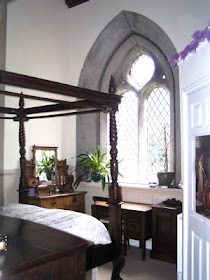


To deconsecrate a church is to remove a religious blessing from it so that it may be given over to secular use or demolished. When churches or chapels that are no longer used for worship are still structurally sound, they are put on the market and purchased by people who want to renovate and reside in a unique environment. Some of the design features that make repurposed churches so desirable to buyers include arches, beams, and domes; floor-to-ceiling windows, and...um...cathedral ceilings. Here are 3 examples:
St. Nicholas Church, Kyloe, Northumberland, England (1st image)
“Taking on this conversion has been a real labour of love. It has totally changed our outlook and the way we live. In fact, now we can’t even visit another church without wondering where we would put the bedrooms!”~Ian Bottomley
St. Nicholas Church was built in 1792, was deconsecrated in the 1980s, stood derelict for almost 20 years before a couple invested nearly 3 times the purchase price to readapt it as a living space. Keeping the stained glass and many of the fixtures intact, they added skylights along the length of the slate roof, weatherproofed the entire building, installed under-floor heating, constructed a dramatic staircase. They used the wood from the pews to build the kitchen counters, cabinetry, and dining room table. The project took 6 years, after which the couple listed the property for approximately £650,000. The property has 1.4 acres of land, an elevated position with a view of the sea, a large garden, outbuildings, and the Georgian-style residence of dressed stone with 4 bedrooms, 2 bathrooms, 2 reception rooms, 2 kitchens, and a huge living area with a 35' ceiling. "The main body of the church has been left open and incorporates the chancel, nave and vestry. This space includes living, dining and kitchen areas, with new stairs rising up to a galleried library at one end. A separate kitchen and sitting room provide more modest winter quarters [since] heating the entire church year-round would prove impractical for just two people."
Church of St. Sylvester, Le Convertoie, Italy (2nd image)
Restoration of this 11th c. church in the Chianti region was done for some clients by an Italian architect and an American designer under the direction of Italy’s historic preservation institution. "Abandoned in the 1950s, it was stripped of its religious art, with only its altars, confessionals and baptismal font left behind. The sacristy, which the previous owners used for storage, was filled with rusted, obsolete farm equipment, an old stove, wine and oil bottles and hunks of salt pork hung from the rafters to cure." The nave has become the living room and the sacristy is now a study.
No comments:
Post a Comment
You may add your comments here.